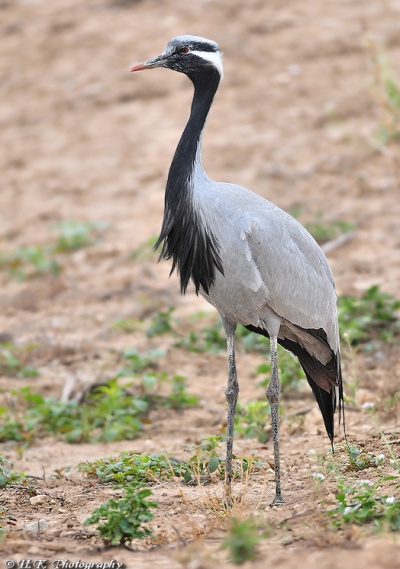- Anthropoides virgo
Grus virgo
Identification
85-100cm (33-39 in)
- Grey white plumage
- Long white neck stripe
- Black marking on foreneck reaching breast
- Red iris
- Black legs
Distribution
Palearctic; winters in north-east Africa and southern Asia
Taxonomy
This is a monotypic species[1].
Habitat
Salt lakes, damp marshes, swamps and meadows near water or arid areas if water is closeby.
Behaviour
Diet
The diet includes seeds, grains and large insects, such as beetles. Lizards and worms are included in the summer months.
Breeding
They nest in a shallow scrape which may be lined with pebbles. The 2 yellowish-green, lavender spotted eggs are incubated by both parents for 27-29 days. The young fledge 55-60 days later.
Vocalisation
Call: loud trumpeting sound.
Recording © by Alok Tewari
A group giving inflight calls.
Jamnagar, Coastal Gujarat, India, December-2010
In the sound file below, a group of few hundred individuals, close to a coastal water collection, moving about, feeding and calling.
Recording by Alok Tewari
Porbandar, Coastal Gujarat, India, December-2010
Gallery
Click on photo for larger image
Large wintering group in India
Photo by Alok Tewari
Jamnagar, Coastal Gujarat, India, 20 January 2016
References
- Clements, J. F., T. S. Schulenberg, M. J. Iliff, D. Roberson, T. A. Fredericks, B. L. Sullivan, and C. L. Wood. 2017. The eBird/Clements checklist of birds of the world: v2017, with updates to August 2017. Downloaded from http://www.birds.cornell.edu/clementschecklist/download/
- Handbook of the Birds of the World Alive (retrieved July 2015)
- Wikipedia
- BirdLife International
- Animal Diversity
Recommended Citation
- BirdForum Opus contributors. (2025) Demoiselle Crane. In: BirdForum, the forum for wild birds and birding. Retrieved 28 April 2025 from https://www.birdforum.net/opus/Demoiselle_Crane
External Links
GSearch checked for 2020 platform.1







